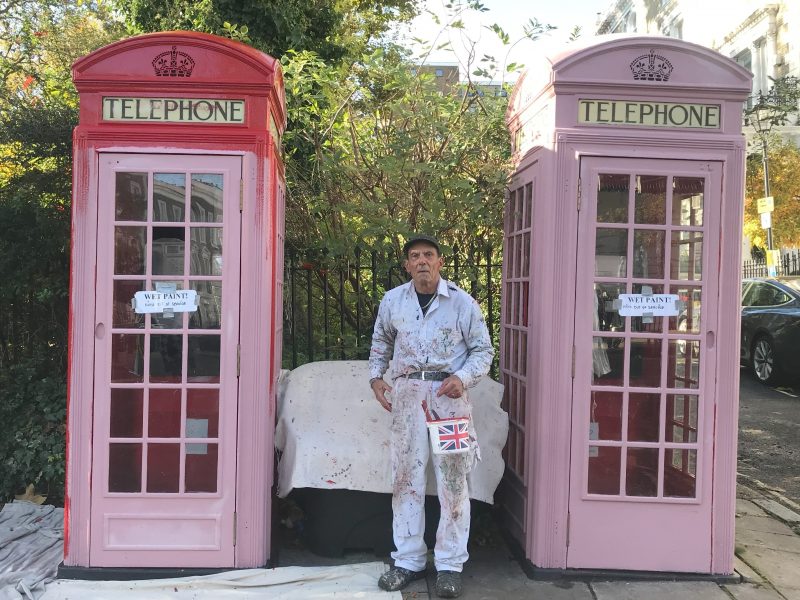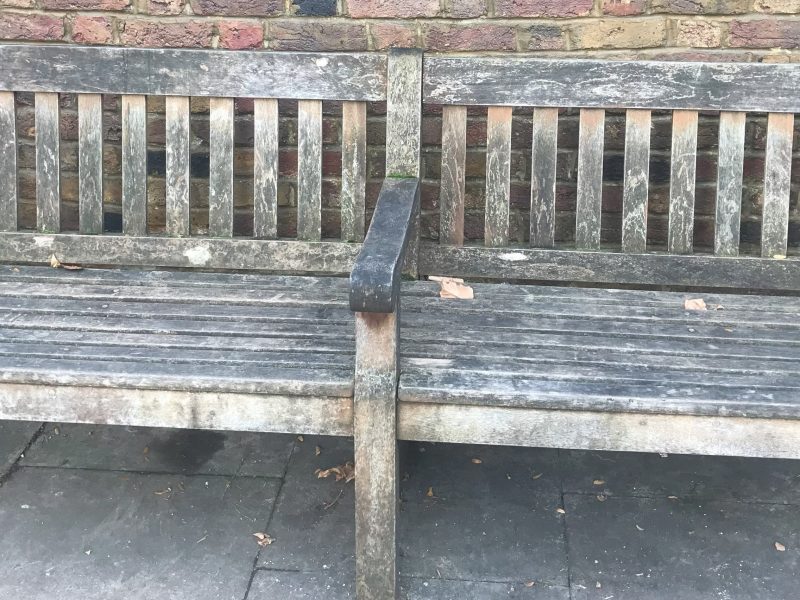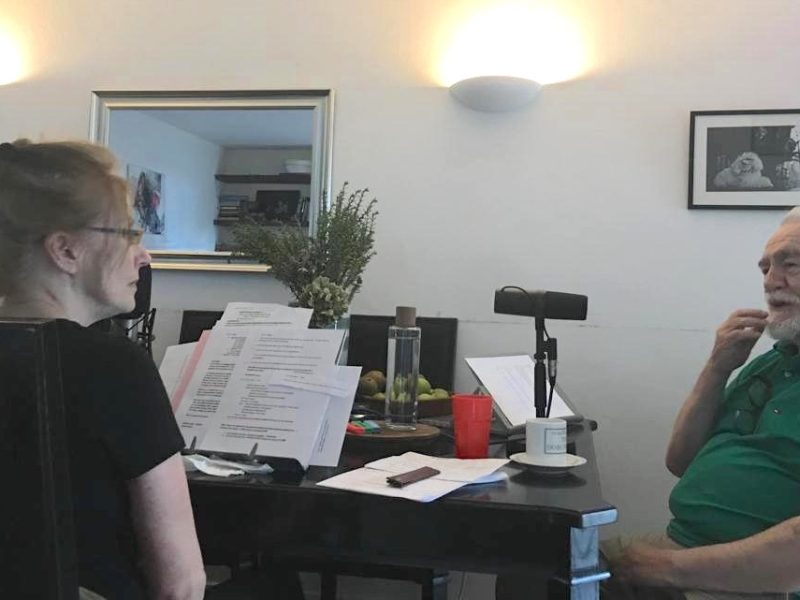By The Mole on the Hill.
The old granddad was talking. “One day I saw Queen go into that house down there at the bottom of the hill.”
“What was she doing there?”
“Not the Queen. Queen. ‘We are the Champions’. ‘We will Rock You’. ‘Hungarian Rhapsody’ ”
So let’s start there. Queen did indeed go to Johnny Dewe Mathews’ studio to be photographed: part of a procession of celebrities, among them Terence Stamp, Pete Townshend and Bryan Ferry. And why St George’s Terrace? Because after Johnny left school, his father insisted that he had to do something practical, so he studied architecture for six years at the Central London Polytechnic. There’s filial obedience for you. His tutor had a flat in St George’s Terrace and told Johnny there was a flat going downstairs. He took it at £14 a month and he is still there, now the owner, fifty years later.
“I’ve been offered a fortune for the flat, but I’ll never leave. It’s where I am. It’s where my identity is.”
Now the flat is Johnny’s studio. He no longer lives there. Instead, he is in little Venice with his wife, the portrait painter Emma Foale. After qualifying, Johnny decided he had missed the excitement of the 1960s so he took himself off to Rome in 1974 for four months. Nonchalantly he says he worked as an extra in films by Fellini and Vittorio de Sica. Then it was off to New York, working as an architect, and then travelling in Mexico and Guatemala.
“When I came back from my travels, a friend of mine, Andrew Logan, asked me if I would take photographs of some of his friends. Andrew later became a celebrated artist in the style of, but way before, Grayson Perry. Even then Andrew had a rich variety of friends, including David Hockney. I had bought a camera in New York, but I had never really used it. I had nothing to lose, so I took the photographs; then in 1972 Andrew organised an exhibition of them at the New Arts Centre, run by Madeleine Bessborough.” This was a coup.
The New Arts Centre, then in Sloane Street, now in Roche Court in Salisbury, was and still is where the world’s most eminent sculptors exhibit their work. There were some good reviews. On the whole, people thought the photographs were quite good, not technically perfect perhaps, but with a naivety and charm.
“I used to develop my photographs in the bathroom and pray that they would come out. Perhaps they were not technically brilliant. But I took them round to David Bailey, who lived in Gloucester Avenue. He was completely dismissive. He said they were crap. At the time Odette’s was a drinking hole for all kinds of celebrities. It was mainly food people and chefs like Peter Lanyon, Richard Shepherd and Albert Roux. I used to meet Patrick Proctor there. He was a very good watercolour artist and, more importantly, he introduced me to Roy Strong, the director of the National Portrait Gallery. Roy said my photographs were “Absolutely charming, innocent, marvellous. You have a good eye and compose nicely.”
The outcome of that meeting was that Johnny was the first photographer to be exhibited at the NPG. One in the eye for David Bailey. It was twenty years before Bailey was given an exhibition there.
One of Johnny’s father’s patients was the manager of Queen; he suggested that as an aspiring photographer Johnny should photograph the band, which he did, both in his studio and backstage at the Rainbow, Finsbury Park in 1974. And the proof is the black-and-white portrait of the band on the cover of Absolute Greatest.
And then Johnny ended his three-year career as a photographer, just like that; he sold all his equipment except for one camera, and bought pencils, brushes and paints. He was to become an artist.
“I decided I didn’t want to be a photographer. You are serving the people you’re photographing. You need them more than they need you. I never saw myself in that light. I didn’t have the courage to go to Vietnam like Don McLean. And I was too shy to be a street photographer. I suspect that if I’d stayed a photographer I’d probably have turned into an extremely unpleasant, wealthy rake.”
[perfectpullquote align=”full” bordertop=”false” cite=”” link=”” color=”” class=”” size=””]I decided I didn’t want to be a photographer. You are serving the people you’re photographing. You need them more than they need you[/perfectpullquote]
The artist in the kitchen.
Instead, Johnny found a new career in the kitchens of great chefs, using watercolour and pencil to capture, with whiplash lines, the movement, the energy, the moment and the intensity of individuals working together with honed skills to produce something – a work of art even. “Simone Green, who owned Odette’s, asked me to go to the restaurant and draw people as they were eating. I’d just settled down when I felt a hand on my shoulder. It was the chef, Mario Lesnik. ‘The real world is down there in the kitchen.’ The heat was unbelievable. After one and half hours, I was drained. I asked if I could come back. ‘By all means. But you cannot leave until I have shown you my art.’ I was presented with a glass of vintage Krug champagne and a delicious meal that, even then, must have cost £150.
Instead, Johnny found a new career in the kitchens of great chefs, using watercolour and pencil to capture, with whiplash lines, the movement, the energy, the moment and the intensity of individuals working together with honed skills to produce something – a work of art even.
“Simone Green, who owned Odette’s, asked me to go to the restaurant and draw people as they were eating. I’d just settled down when I felt a hand on my shoulder. It was the chef, Mario Lesnik. ‘The real world is down there in the kitchen.’ The heat was unbelievable. After one and half hours, I was drained. I asked if I could come back. ‘By all means. But you cannot leave until I have shown you my art.’ I was presented with a glass of vintage Krug champagne and a delicious meal that, even then, must have cost £150.”

Johnny went back often. Mario Lesnik introduced him to Michel Bourdin, the chef at The Connaught, where he drew all through the 1980s. Then he was made an official artist to the Académie Culinaire de Grande Bretagne, of which Michel Bourdin was president.
In 2013 Johnny’s stepson, the celebrated sculptor Conrad Shawcross, curated a show of his kitchen paintings, Behind the Scenes. This was an especial delight for Johnny, because Conrad, the son of William Shawcross and Johnny’s first wife Marina Warner, went on to be the youngest ever member of the Royal Academy; one of his massive sculptures can be seen outside the Crick Institute. Johnny attributes Conrad’s success to the outstanding intellects of both his parents and the imaginative influence he had on the boy as he was growing up. From the age of four, Conrad loved to spend time in the studio with the paints and pencils.
A touch of the sacred
The greatest influences on Johnny seem to have been his parents and the Catholic public school, Ampleforth. “My father used to say to me that there is no difference between a man who bakes a loaf of bread and one who designs a great building, or writes a symphony, or creates an incredible work of art. Learn your craft and, whatever you do, do it to the best of your ability. Ampleforth gave me a very strong sense of the sacred. My housemaster was Dom Basil Hume, who was later to become Cardinal. In the 1970s I abandoned my religious belief, but it came back to me and I have been a practising Catholic since 1978. I don’t think I would have survived as an artist without this sense of the sacred.”
[perfectpullquote align=”full” bordertop=”false” cite=”” link=”” color=”” class=”” size=””]…there is no difference between a man who bakes a loaf of bread and one who designs a great building, or writes a symphony, or creates an incredible work of art. Learn your craft and, whatever you do, do it to the best of your ability[/perfectpullquote]
At the moment, Johnny is working on abstract collages, arranging on canvas cut-out paper shapes painted in acrylics and oils. When you know what you’re looking for, you can see the references to the movement of the chefs. He has given these abstracts titles like Cadence, Flirting, Pendulum, Zigzag. But they are not allegories. What you see is what you get. Buy a secondhand car in America, and on the windscreen you will read AS IS. That’s like Johnny’s work. It’s visceral. It reminds you of Henri Matisse. It might be about sensuality or play. But it is Johnny Dewe Mathews.
“I don’t suppose I’ll be able to stand around in a hot kitchen in my eighties. But I’ll carry on. It’s not conceit, but I have an innate confidence that when I leave this planet, there will be a body of work that will make people say, ‘My God, that guy’s work has joy and it celebrates life.’”
Visit the exhibition
An exhibition of Johnny Dewe Mathews’ work will be held at
5 St George’s Terrace (ring the middle bell)
Primrose Hill,
NW1 8XH
Map here
The exhibition will run from Wednesday 30 May to Saturday 9 June, from 11 a.m. to 6 p.m. every day.





